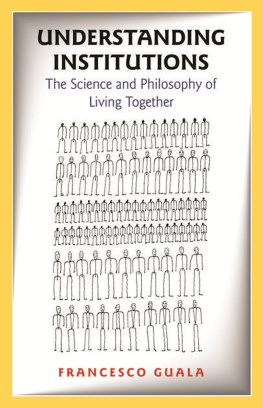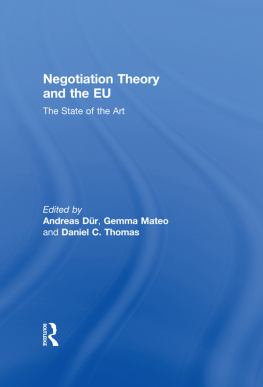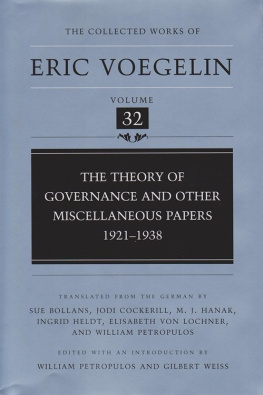Georg Schreyogg - The Hidden Dynamics of Path Dependence: Institutions and Organizations
Here you can read online Georg Schreyogg - The Hidden Dynamics of Path Dependence: Institutions and Organizations full text of the book (entire story) in english for free. Download pdf and epub, get meaning, cover and reviews about this ebook. year: 2009, publisher: Palgrave Macmillan, genre: Politics. Description of the work, (preface) as well as reviews are available. Best literature library LitArk.com created for fans of good reading and offers a wide selection of genres:
Romance novel
Science fiction
Adventure
Detective
Science
History
Home and family
Prose
Art
Politics
Computer
Non-fiction
Religion
Business
Children
Humor
Choose a favorite category and find really read worthwhile books. Enjoy immersion in the world of imagination, feel the emotions of the characters or learn something new for yourself, make an fascinating discovery.

- Book:The Hidden Dynamics of Path Dependence: Institutions and Organizations
- Author:
- Publisher:Palgrave Macmillan
- Genre:
- Year:2009
- Rating:3 / 5
- Favourites:Add to favourites
- Your mark:
- 60
- 1
- 2
- 3
- 4
- 5
The Hidden Dynamics of Path Dependence: Institutions and Organizations: summary, description and annotation
We offer to read an annotation, description, summary or preface (depends on what the author of the book "The Hidden Dynamics of Path Dependence: Institutions and Organizations" wrote himself). If you haven't found the necessary information about the book — write in the comments, we will try to find it.
Georg Schreyogg: author's other books
Who wrote The Hidden Dynamics of Path Dependence: Institutions and Organizations? Find out the surname, the name of the author of the book and a list of all author's works by series.
The Hidden Dynamics of Path Dependence: Institutions and Organizations — read online for free the complete book (whole text) full work
Below is the text of the book, divided by pages. System saving the place of the last page read, allows you to conveniently read the book "The Hidden Dynamics of Path Dependence: Institutions and Organizations" online for free, without having to search again every time where you left off. Put a bookmark, and you can go to the page where you finished reading at any time.
Font size:
Interval:
Bookmark:
Understanding Institutional and Organizational Path Dependencies
Georg Schreygg and Jrg Sydow
The notion of path dependence has become so popular that it is almost commonplace to describe the development of institutions and organizations as being path dependent. This is as true for strategic management and organization theory as it is for economic geography and institutional analysis of society. With its increasing popularity, however, the notion of path dependence has progressively lost a specific meaning. Most often it is merely used as a metaphor accentuating that history matters when explaining cultural artefacts. This is all the more regrettable as problems of path dependence seem to trouble an increasing number of institutions and organizations. No doubt explanations of persistence and rigidity can profit a lot from a re-sharpened concept of path dependence building on the ideas as originally put forward by Paul David (1975, 1985, 1986) and W. Brian Arthur (1989, 1994) in their economic investigation of the diffusion of technologies, the QWERTY keyboard layout being their most prominent example. Some institutional and evolutionary economists have taken up this analytical understanding of path dependence and extended its usage to the institutional area (e.g., North, 1990; Witt, 1997). The same is true for studies in historical institutionalism and comparative politics (e.g., Pierson, 2000), but the bulk of research in these areas, as well as in the field of organizational analysis, refers to the notion of path dependence only in a rather loose way.
As a result of this tendency, the analytical power of (concepts from) the theory of path dependence, by and large, remains underutilized. It is the aim of this edited volume and consequently of this introduction to the book to contribute to a better understanding of institutional persistencies and organizational inertia by referring to the theory of path dependence in a more rigorous manner and to unpack the often hidden dynamics underlying path-dependent processes. In this introductory chapter we will provide a sharpened platform for understanding institutional and organizational path dependence which at the same time serves as an umbrella for the contributions collected for this volume. Many of the contributions have been presented at the international conference Studying Path Dependencies of Businesses, Institutions and Technologies organized by the Research on Organizational Paths center at the School of Business & Economics of Freie Universitt Berlin, Germany, but also at a workshop of the European Institute of Advanced Studies of Management (EIASM), at colloquia of the European Group of Organization Studies (EGOS), and at annual meetings of the Academy of Management (AOM). Finally, this introductory chapter will give an overview of the contributions to this volume.
The basic point of any path-dependence argument provided so far stresses the importance of past events for future action or, more precisely, of foregoing decisions for current and future decision making. Hence, decisions are conceived as historically conditioned: bygones are rarely bygones (Teece, Pisano and Shuen, 1997: 522). Although this insight has certainly advanced the building of a time-sensitive understanding of institutional and organizational phenomena and helped to overcome the a-historical and unbounded view of rational choice thought, it is too vague a perspective. Path dependence means more than a mere past-dependence (Antonelli, 1999) as such an all-embracing understanding of path dependence does not enable us to better understand the specific dynamics of locked institutional and organizational processes and their underlying forces.
In a first attempt to develop a more specific understanding we can say that path dependence implies at the very least a sequence of events narrowing the scope of action eventually resulting in a state of persistence or inertia. Valuable insights in the dynamic nature of entrapping or locking processes have been provided by studies from evolutionary economics (David 1985, 1986, 1993, 2007; Arthur, 1989, 1994; Dosi, 1982, 1997). In those accounts, decisions taken in the past can increasingly restrain future choices. The decision pattern used repeatedly in the past may even amount to an imperative for the future course of action so that ultimately no further choice is left. In order to explain the dynamics of these processes, self-reinforcing processes have been identified as major drivers which are likely to accumulate in a specific path of action. The inherent self-reinforcing dynamics being driven typically by the externalities arising from the actions of other agents, or strongly routinized (learned) individual behaviors is likely to pass quickly beyond the control of any individual actor; the regime takes the lead and potentially renders the process into a non-reversible state of local equilibrium or lock-in (David, 1985, 1993).
This brief illustration also highlights that the process of shaping a path cannot be characterized by the same structural properties at any point in time in the process. The initial situation differs completely from the final situation. Therefore, we suggest subdividing the whole process into different stages governed by basically different regimes. We propose distinguishing three phases in the process of bringing about path dependence (cf. Sydow et al., 2009):
Phase I the Preformation Phase can be characterized by a broad scope of action, where choices taken cannot be predicted by prior events or initial conditions (Mahoney, 2000: 511). Up to a certain degree the first phase is, however, also influenced by the past. Thus, Phase I should conceptually build on historically framed and imprinted contingency and not on completely unrestricted choice as rational choice models do. Once a decision is made on whatever basis this choice may turn out to be a small event. If so, this innocent decision sets into motion self-reinforcing processes. The shadow in Phase I in is supposed to indicate this thought. The moment of entering into the dynamics of a self-reinforcing process can be conceived of as a critical juncture (Collier and Collier, 1991).
In Phase II the Formation Phase the range of options increasingly narrows and it becomes progressively difficult to reverse the initial choice, i.e. a path is evolving. In this phase of path-building a new regime takes the lead: the dynamics of self-reinforcing processes, conceptualized by Arthur (1989, 1994) as increasing returns. On a general level, the notion of increasing returns highlights positive feedback processes in which the increase of a particular variable leads to a further increase of this very variable. The notions of increasing returns or positive feedback indicate self-reinforcing processes with growing benefits which are likely to culminate in a patterned dynamic. Eventually, a dominant institutional or organizational solution emerges. The other side of the coin is that the probability of the direction of evolution exhibited by the macro-process being reversed is tending to decrease with each successive step of its unfolding, and in that sense the system is becoming committed to only one or a small subset of the originally possible outcomes. Decision processes in Phase II are, however, still contingent, i.e. essentially constrained choices are still possible. As David (1985, 2007) puts it, the processes are non-ergodic, i.e., their motion is neither pre-determined nor random but their evolvement proceeds under the influence of its own history, which in effects selects one or another among the many outcomes that potentially might have been attained.
The empirical studies that have provided ample evidence for the existence of self-reinforcing and non-reversible dynamics have been primarily conducted in the field of technology development and diffusion. In economic studies (Arthur, 1994; Cowan, 1990; Katz and Shapiro, 1985, North 1990) so far, basically six types of self-reinforcing dynamics can be identified: economies of scale, (direct and indirect) network externalities, learning effects, adaptive expectations, coordination effects, and complementarities. Examining the economic effects in more detail reveals, however, that they develop under special conditions only, namely if the decision to reproduce a particular option is suggested by a utility calculus. Without excluding this case, it seems too restrictive a starting point for explaining institutional and organizational paths (see also ). As is well known from
Font size:
Interval:
Bookmark:
Similar books «The Hidden Dynamics of Path Dependence: Institutions and Organizations»
Look at similar books to The Hidden Dynamics of Path Dependence: Institutions and Organizations. We have selected literature similar in name and meaning in the hope of providing readers with more options to find new, interesting, not yet read works.
Discussion, reviews of the book The Hidden Dynamics of Path Dependence: Institutions and Organizations and just readers' own opinions. Leave your comments, write what you think about the work, its meaning or the main characters. Specify what exactly you liked and what you didn't like, and why you think so.






